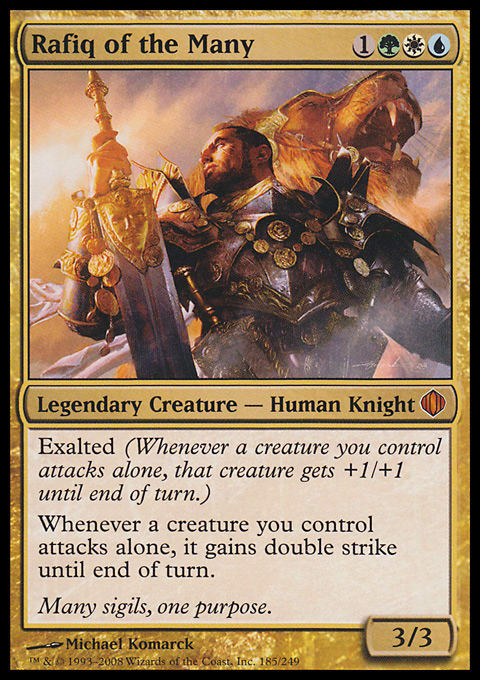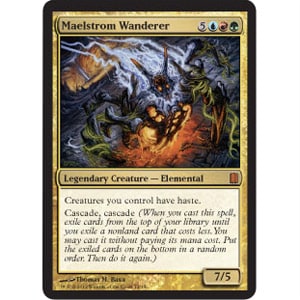Sorry to mislead; there’s no artwork to be found here today. I don’t want to talk about card art—I’ll leave that to the professionals. No, today, I want to talk about Sun Tzu’s The Art of War and how some of Sun Tzu’s principles can inform some of our own in 75% deck-building as well as any other kind of Constructed or Limited Magic. There are several passages that influenced me as a young Magic player, and that ethos has helped to shape me as a player and ultimately informed how I approached 75% deck-building. I thought it would be fun to go back and take a look at how that all happened.
The Art of War is a terrible Wesley Snipes movie, but it’s also a brilliant treatise on military strategy attributed to Chinese general and tactician Sun Tzu. It is divided into thirteen chapters, and all of them are about, well, the art of war. It’s highly regarded as one of the most important treatises about military strategy, and it’s required reading in the Chinese military. I’m not sure if the U.S. military reads it, too. I think they read Ender’s Game. Regardless, I bought a translated copy when I was in high school, and I’ve read through it many times, although I doubt I am really scratching the surface in terms of understanding it.
Make no mistake, some of these lessons could be very easy to misinterpret. ““When the enemy is at rest, harry him,” you say? Judge? Can you come watch my opponent for slow play?” Also, I would avoid Chapter 12 entirely because it mostly deals with how to attack your opponent using fire. You’d think it would be good advice for someone playing a burn deck. You’d be wrong; it mostly deals with shooting flaming arrows at their camp while they’re sleeping and burning their baggage trains. That’s good advice, I guess, but it’s not for our Magic game. Still, there are a lot of good chestnuts in The Art of War, and I want to talk about a few and how they influenced me.
A key principle of 75% deck-building is scalability—namely, using opponents’ spells against them as a way to tailor the power level of the plays you make to their decks. The better their decks, the better the play, and you are in this way able to dial in your deck’s power level without having to predict anything. You react to the situation perfectly, and in the process, you remove a powerful obstacle to victory and gain a powerful aid to your victory at the cost of one card. It’s brilliant, and it’s the reason Bribery and Desertion cost so much mana and why they’re two of my favorite cards for 75% deck-building. Even Threaten effects get there, and it’s why people are so much saltier when you play Insurrection than when you play Damnation.
Doing something unexpected with your commander is a great way to make sure you’re underestimated. Running a combo deck in non-traditional combo colors with a non-traditional commander is a good way to accomplish this. I like the Marath, Will of the Wild deck we came up with, for example. They expect one thing when they see Marath on the mat. Why not hit them with something different? By the time they realize what’s happening, it may be too late.
The quicker games go, the more games you can play. No one wants to spend two hours durdling, which is why it’s important to be able to make a game end. I don’t think that using a ton of tutors to make secret plans your opponent can’t see is what we aim for in 75% decks, but sometimes, a timely tutor for a silver bullet to make the game end is important, and 75% takes a pretty unique approach to tutors. Notice that the Mayael the Anima deck also contains Insurrection. It’s not just for taking bushels of the opponent’s grain twenty at a time; sometimes, you just want the stupid game to end, and breaking up a board stall is just what the doctor ordered.
It’s important to have a “thing.” As much as Sun Tzu would disagree with our axiom that says it’s better to punish our enemies for doing something than it is to prevent them from doing those things, this axiom is what sets us above someone trying to destroy his enemies. We’re playing a social game in a social setting, and while you should always try to win, you don’t need to annihilate everyone to do it. You do need to have a plan and execute it. Your deck should have a thing it’s trying to do. Do your thing, make sure opponents doing their things isn’t a threat to you winning the game, and most importantly, have fun. Build to win; play to have fun and do your thing.
This list is far from exhaustive, but it’s a few of the principles from The Art of War that have guided me in the development of the 75% principles. Are there more lessons buried in this ancient text waiting for us to coax them out? Absolutely. I recommend acquiring a copy and reading for yourself. Next week, I’ll try to have a decklist for us to look at. Until then, have fun chowing down on your enemies’ grain.



























